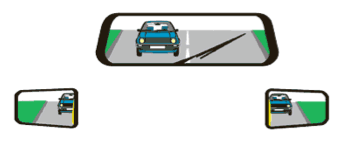Lesson Plan 2 - Moving Off and Stopping
Moving Off
To move off safely, you must do so without creating a hazard to other road users, therefore when moving off you must avoid causing anyone to change their speed or direction because of your actions. It is safer to move off from the left as we drive on the left hand side of the road therefore you won’t have to cut across oncoming traffic. On your driving test you may be required to pull up somewhere convenient on your left, possibly several times, and move off again when clear, moving off safely and in full control of your vehicle.
Prepare
- Press clutch pedal all the way down
- Select first gear
- Set gas (press accelerator slightly)
- Slowly raise clutch pedal to biting point and hold feet still
Observation
- Check your mirrors (interior and then right hand door mirror)
- Look over your right shoulder to cover blind spots (highlighted on the diagram)
Move
- Consider a signal – apply when other people would benefit
- Release handbrake
- Slowly raise clutch pedal (keeping on gas)
- Steer to your normal driving position
- Cancel signal


Hill starts and moving off at an angle
Moving off uphill
Prepare
- The steeper the incline then you should raise clutch higher at biting point to avoid rolling back
- Make sure the handbrake is applied fully to secure the car, especially on a steep hill
- Keep feet still at the biting point
Observation
- Check your mirrors
- Keep on footbrake and release handbrake
Move
- When clear consider a signal – apply if anyone will benefit
- Give a little more gas as you release the handbrake
- Keep in first gear for longer before changing to second as you will need more power going up a hill
Moving off downhill
Prepare
- If it’s a steep hill you can move off in second gear
- Keep on footbrake and release handbrake
Observation
- Check your mirrors
- Look over your right shoulder to cover blind spots
Move
- Release footbrake, raise clutch pedal up and give gas if you need to build up speed
Moving off from behind a parked car
Prepare
- Find biting point (don’t raise clutch pedal too high)
Observation
- Check your mirrors
- Look over your right shoulder to cover blind spots
- Look for oncoming traffic
- Look out for hazards in front of parked car
Move
- It will be more likely that a signal will be required to warn others
- Move out slowly with the clutch just at or above biting point – to control speed do not raise pedal all the way up too soon
- Steer enough around obstruction trying to give a car door’s clearance where possible
Stopping
You will need to ensure you stop somewhere safe, legal and convenient. On your driving test you may be required to pull over and park on the left, possibly several times. As you are changing speed and direction then you should follow the Mirrors Signal Manoeuvre (M-S-M) routine (as shown on the diagram below). Do not park where you will create a hazard to other road users i.e. on or near a bend, a brow of a hill, too close to junctions etc.
Following Traffic
Be aware of traffic possibly following closely behind.

Mirrors
Check your mirrors well before commencing manoeuvre to assess distance and speed of any following traffic.
Signal
After you have picked a suitable place to stop and mirrors have been checked apply a left signal if anyone behind or ahead would benefit. There would be no harm in signalling every time. Cancel signal when parked.
Position
Steer closer to the kerb where possible to help following traffic pass.
Speed
Gently brake until almost at a stop – apply clutch and steer closer to the kerb, aiming to be approximately 6 inches away.
Look
Keep driveways clear etc. and then brake to a complete stop – keep clutch and brake pedal applied. Select handbrake and neutral, then you can rest your feet. If signal is still on – cancel.
Try to avoid parking opposite other parked cars and obstructions.
(Convenient)
Road Markings and Signs
 | Do not stop on zig zag markings |
 | No waiting at any time |
 | No waiting during times shown on sign |
 | No stopping at any time |
 | No stopping during times shown on sign |
